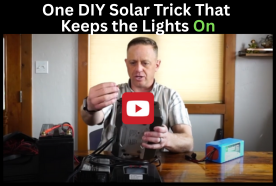How to Heat a Room Without Electricity (And Not Burn Your House Down) – Survivopedia

Heat isn’t just about comfort when the power goes out because a cold room drains your energy, weakens your immune system, and turns simple tasks into hazards. Every winter storm, grid failure, and fuel shortage proves the same thing.
Most homes lose heat faster than people realize, and once the temperature drops, getting it back up without electricity becomes a real fight. Whether you live in a city apartment or a rural homestead, you need to learn how to keep a room warm without putting your home at risk.
Understanding Heat Loss
Cold doesn’t invade your home on its own, but rather slips in through every weak point in the building, and most people don’t realize how many of those weak points they have. Heat moves in three ways: conduction through solid surfaces, convection through air leaks, and radiation through exposed windows or thin walls. When the power goes out, all three go to work immediately.
The biggest culprit is air exchange. Even a small gap under a door can empty a room of warm air in minutes. Old windows leak even faster and thin drywall, uninsulated exterior walls, and large panes of glass all accelerate heat loss. Once a room begins to cool, every piece of furniture becomes a heat sink that absorbs warmth from the air.
Most people think their home is insulated, but insulation only works if you stop airflow. That’s why even brand-new homes can feel cold when the grid drops. Before you worry about heaters or candles, your first line of defense is sealing leaks and reducing the space you need to heat.
Passive Insulation
Before you light a single candle or build a solar heater, you need to trap the heat you already have. Passive insulation is the fastest, safest way to warm a room without electricity, and you can do it with items already in your home.
Start with the windows because glass leaks heat nonstop. Hang heavy curtains, blankets, or quilts to slow the loss. Let sun hit the glass during the day, then cover it at dusk. For older windows, seal seams with rolled towels or tape to block drafts.
Doors leak too and the gap underneath can pull warm air out fast, so plug it with a door snake or rolled blanket. Close off rooms you aren’t using to shrink the space you’re heating. Smaller rooms warm up faster and stay warm longer.
Floors steal heat as well and you’ll need to cover bare floors with rugs, towels, or clothes to keep your feet warm and stop heat absorption. If walls feel cold, hang blankets for an extra insulating layer.
Best trick of all: build a warm room. Pick a small interior space, seal it tight, insulate everything, and sleep there. Your body heat alone raises the temperature, and paired with a safe heat source, it’ll keep you comfortable even if the rest of the house freezes.
The Tealight & Clay Pot Heater: How to Use It Safely Indoors
The tealight-and-clay-pot heater is one of the most misunderstood emergency heating setups. People see viral videos claiming it can heat an entire house, but I can tell you from experience ethat it can’t. However, when used correctly, it can make a small insulated room noticeably warmer without electricity.
A tealight produces a small flame with predictable heat output. When you place a clay pot over several tealights, the pot absorbs that heat and radiates it out slowly and evenly. This creates gentle convection that warms the air around the heater. The effect is modest, but in a tight warm room, even a few degrees can make a big difference.
Use a ceramic or terra cotta pot, not metal, because metal can overheat quickly. Elevate the pot on nonflammable spacers like bricks, stones, or metal nuts. Place tealights on a metal tray to catch wax and stabilize them.
Ventilation is important too because even tealights consume oxygen and produce small amounts of carbon monoxide. Crack a window slightly or ensure the room has some airflow. The goal is warmth, not a sealed box.
How many tealights should you use? Four to eight is typically the way to go. More than that increases fire risk without adding meaningful heat.
Friendly advice: Never leave it unattended because a bumped table or dripping wax can cause ignition if you’re not watching.
Solar Heating Indoors
Solar heat is free, silent, and safe, and people overlook it in emergencies. You don’t need panels and if sunlight hits your home just right, you already have usable heat. Now you need to capture and keep it.
Use south-facing windows first and open curtains during the day and let the sun warm the room. Dark items placed in direct sun absorb heat and release it slowly after sunset. If every degree matters, concentrate your efforts here.
To boost output, make a simple DIY solar box heater for a sunny window. Cardboard, foil, black paint, and clear plastic are enough. Foil lines the inside, the black surface absorbs heat, and the transparent front traps sunlight so the box warms air and releases it into the room. Even basic versions help in small insulated spaces.
Place it where sunlight is strongest and avoid blocking airflow. It won’t replace a heater, but it adds to your overall heat strategy.

Heat From Body Mass, Cooking, and Moisture Control
When electricity disappears, one of your most reliable heat sources is already in the room: you and the other breathing and living bodies in the home. A resting adult radiates roughly the same heat as a small space heater on its lowest setting. It’s not ideal, but in a properly insulated warm room, several people can raise the temperature a few degrees just by being there. That’s why shrinking your living space matters so much and the smaller the room, the more that body heat pays off.
Cooking is another hidden heat source and a pot of boiling water, a pan warming on a safe indoor stove, or even a slow simmer adds heat and humidity. But safety is everything here and you need to use cooking devices rated for indoor use, like gas stoves, alcohol burners, or Sterno-type fuels. Never try to heat a room with an oven or an open-flame camp stove meant for the outdoors because carbon monoxide risk is real, and too many people get in trouble thinking they can “just leave it on for a minute.”
Moisture also changes how warm a room feels. Humid air holds heat better, but too much humidity makes the room feel clammy and cold again. A small pot of hot water can add just enough moisture to make the air feel warmer without soaking your walls or windows. Dry air, on the other hand, makes cold bite deeper and faster. The trick is balance and you have to keep the air breathable, avoid condensation buildup, and don’t let surfaces get wet enough to grow mold.
When combined, body heat plus a little cooking warmth plus balanced humidity can transform a cold night into a manageable one. None of these methods are flashy, but they’re safe, sustainable, and reliable when bigger heating options aren’t available.
Putting It All Together
When the power goes out and the temperature drops, the fastest path to staying warm is having a simple plan you can activate instantly. You don’t need complicated setups or risky improvisation and you just need order, timing, and safe methods working together.
Start by choosing a single warm room. Pick a small interior room or a south-facing one if sunlight is available and shut all other doors. Lay down rugs, hang blankets on walls, and cover windows after sundown and don’t forget to seal gaps under doors with towels. This alone can raise the temperature several degrees.
Next, introduce low-risk heat sources. During daylight, pull back curtains on sunny windows and place dark objects in the sun to soak up warmth. If you have a solar box heater, position it for maximum gain. As evening arrives, switch to controlled indoor-safe options. A tealight-and-clay-pot setup can provide gentle warmth, but always keep it supervised and on a fireproof base. Canned heat or an indoor-rated catalytic heater can supplement it, as long as ventilation is maintained and a carbon monoxide detector is present.
Your own movement adds heat too. Warm food, hot drinks, and safe indoor cooking release more warmth into the space. Use thermal mass wisely. Heat bricks or water bottles with safe devices and place them under blankets or at your feet for long-lasting comfort.
Through the night, aim for stability rather than intensity and minimize flame use and rely more on stored heat from thermal mass, insulated bedding, body heat, and wind protection. If temperatures drop sharply or your heating method becomes unstable, shut everything down and reassess safely.
This layered approach works because each step supports the next. Trap heat first, generate small amounts safely, and maintain airflow. Done correctly, you can stay warm for days without electricity and without risking your home.

Concluding
Losing power in cold weather turns comfort into survival fast, especially if you live in areas with harsh winters. However, staying warm doesn’t have to mean taking dangerous shortcuts or trying desperate tricks that put your home at risk.
The safest approach is usually the simplest one and you need to trap the heat you already have, shrink your living space to a warm core, and rely on low-risk, predictable methods that add just enough warmth to stay comfortable.
A clay-pot heater, passive solar gain, insulated walls, indoor-rated fuel sources, and smart humidity control all work together when you layer them properly. None of these techniques will turn a freezing house into a sauna, but they will keep a room livable, stable, and safe until the grid comes back.






Read the full article here









